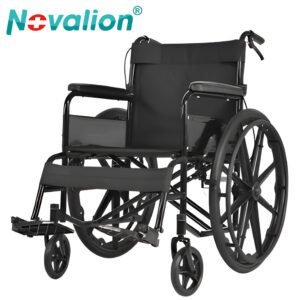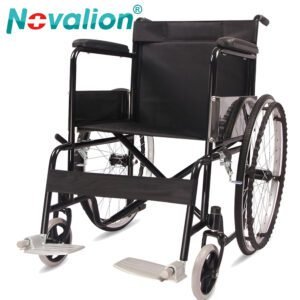Bariatric Wheelchair 400 lb Capacity: Your Guide to Safe, Heavy-Duty Mobility
For individuals needing a wheelchair that can reliably support up to 400 pounds, a bariatric wheelchair with this specific capacity is a critical tool for maintaining independence. But what makes these wheelchairs unique? How do they differ from other bariatric models? This guide answers all your questions about 400 lb capacity bariatric wheelchairs, from their design to how to choose, use, and maintain one.
What is a bariatric wheelchair with 400 lb capacity?
A bariatric wheelchair with 400 lb capacity is a heavy-duty mobility device engineered to safely support users weighing up to 400 pounds. It sits in the mid-range of bariatric options—between standard wheelchairs (max 300 lbs) and higher-capacity models (500+ lbs)—making it ideal for those who need more support than standard chairs offer but don’t require the extreme strength of ultra-heavy-duty designs. These wheelchairs feature reinforced steel or aluminum frames to handle the weight, wider seats (typically 20–24 inches), and robust components like large, sturdy wheels and heavy-duty brakes. They balance durability with maneuverability, ensuring users can navigate both indoor spaces (homes, hospitals) and outdoor paths comfortably.
How does it differ from other bariatric wheelchairs?
The key distinction is its weight range, which shapes its design:
- Capacity focus: Unlike 500+ lb capacity models (built for larger frames with extra reinforcement), 400 lb capacity wheelchairs are lighter and more maneuverable, making them better for daily use in tighter spaces like home hallways. They don’t sacrifice strength but avoid the bulk of higher-capacity chairs.
- Size and portability: Higher-capacity bariatric wheelchairs (600+ lbs) often have wider seats (26+ inches) and bulkier frames, which can be hard to move through doorways. 400 lb models typically have seats 20–24 inches wide—still spacious but more practical for standard home or facility layouts. Many are foldable, a feature less common in ultra-heavy-duty chairs.
- Стоимость: 400 lb capacity wheelchairs are generally more affordable than 500+ lb models, as they require less extreme reinforcement. This makes them a budget-friendly option for those who need 400 lb support but not higher.
Who needs a 400 lb capacity bariatric wheelchair?
This type of wheelchair is tailored to individuals whose weight falls within 300–400 pounds. It’s ideal for:
- Adults with moderate obesity: Those who exceed standard wheelchair limits (300 lbs) but don’t need the extra capacity of 500+ lb models.
- Users in home or facility settings: Whether navigating a house, hospital, or care home, the chair’s balance of width and maneuverability works well in typical indoor spaces.
- Short or long-term use: Suitable for post-surgery recovery, chronic mobility issues, or permanent disability, as long as the user’s weight stays within the 400 lb limit.
What features should you look for when choosing one?
Prioritize these to ensure safety and comfort:
- Weight capacity verification: Always confirm the manufacturer’s stated limit is at least400 lbs. Avoid models that “round up” their capacity—exceeding the limit risks frame damage or tipping.
- Размеры сиденья: A seat width of 20–24 inches and depth of 18–20 inches accommodates most users in this weight range without feeling cramped. Look for padded, breathable upholstery to prevent pressure sores during long use.
- Frame material: Reinforced steel or heavy-gauge aluminum frames are best. Steel offers maximum durability but adds weight; aluminum is lighter, making the chair easier to push (important for caregiver-assisted models).
- Колеса и тормоза: 16–20 inch rear wheels with sturdy spokes support the weight, while front casters should be 8+ inches to avoid getting stuck on thresholds. Brakes must be heavy-duty—prefer “parking brakes” that lock securely, even on inclines.
- Возможность складывания: If you need to transport the chair (e.g., in a car), choose a foldable model. Check the folded dimensions to ensure it fits in your vehicle.
How to use it safely?
- Never exceed the 400 lb limit: Even if the user is close to 400 lbs, avoid adding heavy items (e.g., backpacks, oxygen tanks) that push the total over the capacity.
- Secure transfers: Always lock the brakes before getting in or out. Use transfer boards or have a caregiver assist to prevent sudden shifts that could tip the chair.
- Maneuvering care: Take wide turns to avoid hitting walls or furniture—this prevents frame damage. On slopes, go forward (never backward) and have a helper steady the chair.
- Regular checks: Before each use, inspect wheels for loose spokes, brakes for firmness, and the frame for cracks. Tighten any loose bolts immediately.
Какое обслуживание требуется?
- Очистка: Wipe down the frame, seat, and wheels weekly with mild soap and water to remove dirt and sweat, which can corrode metal. Pay extra attention to brake components—grime can weaken their grip.
- Wheel care: Check tire pressure (for pneumatic tires) monthly; under-inflation strains the frame. For solid tires, inspect for cuts or uneven wear. Lubricate wheel axles quarterly to keep movement smooth.
- Brake upkeep: Test brakes weekly by locking them and trying to push the chair—if it moves, adjust the brake pads or tighten the cables. Replace worn brake pads promptly.
- Frame inspection: Look for rust (on steel frames) or bent parts. Treat rust with a wire brush and rust-resistant paint; contact the manufacturer if the frame bends—this compromises safety.
Where can you buy a 400 lb capacity bariatric wheelchair?
- Магазины медицинских товаров: In-person shops let you test the chair’s fit and maneuverability. Chains like Medline or local stores often carry top brands (e.g., Drive Medical, Invacare).
- Интернет-магазины: Amazon, eBay, and medical sites (e.g., com) offer a wide selection with customer reviews. Look for free returns in case the chair doesn’t fit.
Страховое покрытие: Many plans, including Medicare, cover these wheelchairs with a doctor’s prescription (stating medical necessity). Check with your provider to confirm coverage details.
Are there reliable brands for this capacity?
Yes, trusted brands specialize in 400 lb models:
- Drive Medical Bariatric Wheelchair: Offers 400 lb capacity, 22-inch seats, and foldable frames—popular for home use.
- Invacare Bariatric Manual Wheelchair: Features reinforced steel frames, large rear wheels, and adjustable footrests for customization.
- Medline Heavy-Duty Wheelchair: Known for durable aluminum frames, making it lighter for caregivers to push.
A 400 lb capacity bariatric wheelchair balances strength and practicality, letting users move safely and independently. By focusing on key features, safe use, and regular maintenance, you can choose a chair that meets your needs for years.
Спасибо, что прочитали это, дорогие, если у вас есть какие-либо предложения по поводу наш сайт или хотите узнать о коляске, пожалуйста связаться с нами. Мы быстро ответим.



